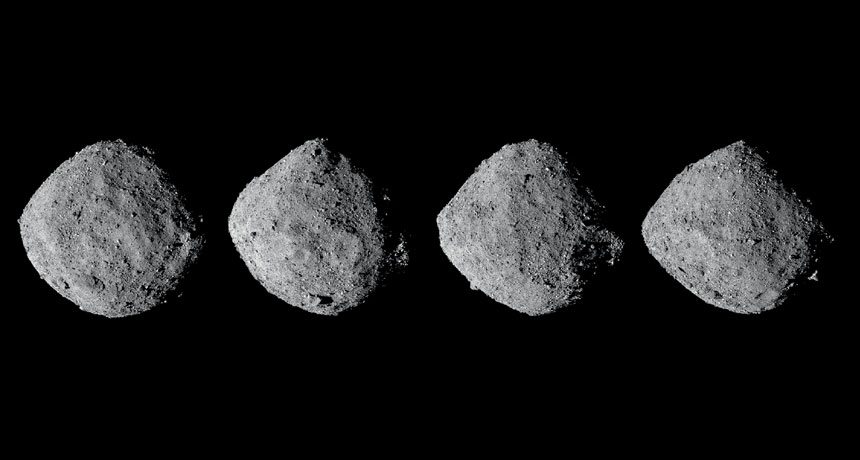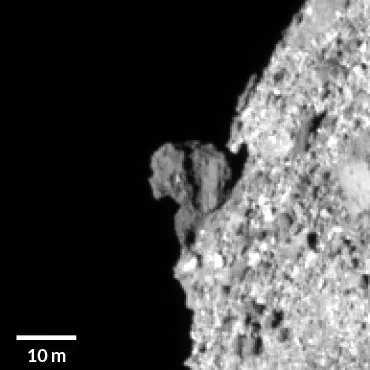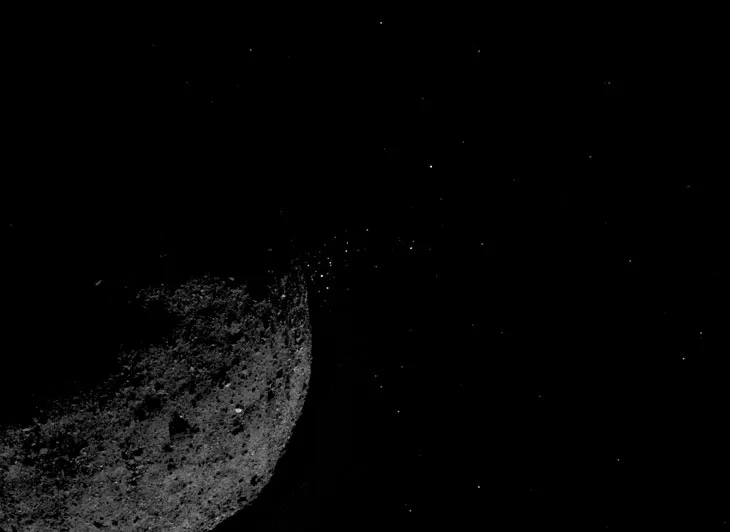Surprising astronomers, Bennu spits plumes of dust into space
It’s the first time astronomers have seen such activity on an asteroid

BOULDERY BENNU Near-Earth asteroid Bennu (shown in multiple views from the OSIRIS-REx spacecraft) surprisingly erupts plumes of dust from its rocky surface.
D.N. DellaGiustina et al/Nature Astronomy 2019
- More than 2 years ago
THE WOODLANDS, Texas — Like the “Peanuts” character Pigpen, the near-Earth asteroid Bennu moves around in a cloud of its own dust.
NASA’s OSIRIS-REx spacecraft has watched Bennu spit out plumes of dust 11 times since the spacecraft arrived at the asteroid in December 2018. And some of that dust is caught in orbit around the asteroid, scientists announced March 19 at the Lunar and Planetary Science Conference. It’s the first time astronomers have spotted such activity at an asteroid.
“Definitely we did not expect to see this,” said OSIRIS-REx principal investigator Dante Lauretta of the University of Arizona in Tucson. “We are probably seeing a new kind of activity at asteroid Bennu.”
While this result has planetary scientists excited, the overall news from Bennu is mixed. OSIRIS-REx’s primary mission is to collect dust from the asteroid in 2020 and bring it back to Earth in 2023, in hopes that the rubbly, water-rich asteroid holds clues to the origin of life in the solar system (SN: 1/19/19, p. 20). But that job may prove tricky. In a series of studies in Nature journals released March 19, the OSIRIS-REx team reports that the space rock is a minefield of boulders much bigger than the craft was designed to navigate.

OSIRIS-REx arrived at the near-Earth asteroid on December 3, when the rock was about 130 million kilometers away from Earth (SN Online: 12/3/18). To the team’s surprise, OSIRIS-REx’s navigation cameras picked up several bright spots floating near the asteroid on January 6.
Analyzing the spots revealed that they were eruptions of dust particles from Bennu’s surface. The particles were ejected at speeds between a few centimeters per second and 3 meters per second. Some of the dust is flying off into space, but some is getting caught in orbit around Bennu, Lauretta said. The team saw 11 separate plumes from January 6 to February 18.
“I’m amazed,” says planetary scientist William McKinnon of Washington University in St. Louis, who is not part of the OSIRIS-REx team. “I’ve never heard of this before. That’s the coolest thing so far.”
Lauretta and colleagues aren’t sure what causes the plumes. One idea is that Bennu’s subsurface contains volatile gases, which escape from the rock as the sun heats them up and push out plumes of dust in the process. If so, Bennu may have reached near-Earth space relatively recently, though it’s unclear exactly when. Because the asteroid was likely born further from the sun in the asteroid belt between Mars and Jupiter, it probably would have lost those volatiles had it wandered into the inner solar system a long time ago, the scientists say.
The team doesn’t think that the dust poses a danger to the spacecraft. But Bennu’s surface might.

The plan was for the craft to briefly land in a region at least 50 meters wide, where a vacuumlike instrument would collect dust no larger than 2 centimeters across. But there are no clear regions that are wide enough on Bennu’s surface. Most of the asteroid is a boulder field, and the widest areas of small, sandy particles span just 20 meters. The team is working on adjusting its plans to successfully grab the goods from a smaller area.
“We do have sampleable material on this asteroid,” DellaGiustina says. “It’s not a wonderful sandy asteroid full of these centimeter-scale particles that we were hoping for, but it is a workable situation.”
Another asteroid sample return mission may offer more hope. The Japanese Hayabusa2 mission is also exploring a boulder-covered asteroid, called Ryugu. And Hayabusa2 seems to have taken a sample of material on February 21 (SN Online: 2/22/19). “That gives us a lot of confidence,” DellaGiustina says. The OSIRIS-REx team is planning to meet with the Hayabusa2 team to see what lessons can be learned.







